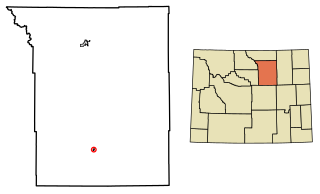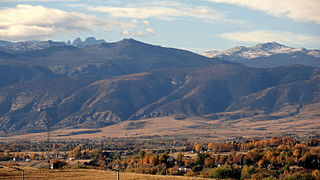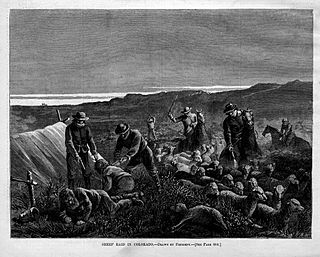
The Johnson County War, also known as the War on Powder River and the Wyoming Range War, was a range conflict that took place in Johnson County, Wyoming from 1889 to 1893. The conflict began when cattle companies started ruthlessly persecuting alleged rustlers in the area, many of whom were settlers who competed with them for livestock, land and water rights. As violence swelled between the large established ranchers and the smaller settlers in the state, it culminated in the Powder River Country, when the former hired gunmen invaded the county. The gunmen's initial incursion in the territory alerted the small farmers and ranchers, as well as the state lawmen, and they formed a posse of 200 men that led to a grueling stand-off. The siege ended when the United States Cavalry on the orders of President Benjamin Harrison relieved the two forces, although further fighting persisted in the following months.

Kaycee is a town in Johnson County, Wyoming, United States. The population was 247 at the 2020 census. It is home to a museum that preserves the cattle ranching heritage of the area, especially the history of the Johnson County War.

Arvada is a census-designated place in Sheridan County, Wyoming, United States. The population was 33 at the 2020 census.

Sheridan is a city in the U.S. state of Wyoming and the county seat of Sheridan County. The city is located halfway between Yellowstone Park and Mount Rushmore by U.S. Route 14 and 16. It is the principal town of the Sheridan, Wyoming, Micropolitan Statistical Area which encompasses all of Sheridan County. The 2020 census put the city's population at 18,737, making it the 6th most populous city in Wyoming.

Buffalo Soldiers were United States Army regiments that primarily comprised African Americans, formed during the 19th century to serve on the American frontier. On September 21, 1866, the 10th Cavalry Regiment was formed at Fort Leavenworth, Kansas. The nickname "Buffalo Soldiers" was purportedly given to the regiment by Native Americans who fought against them in the American Indian Wars, and the term eventually became synonymous with all of the African American U.S. Army regiments established in 1866, including the 9th Cavalry Regiment, 10th Cavalry Regiment, 24th Infantry Regiment, 25th Infantry Regiment and 38th Infantry Regiment.

Thomas Horn Jr., was an American scout, cowboy, soldier, range detective, and Pinkerton agent in the 19th-century and early 20th-century American Old West. Believed to have committed 17 killings as a hired gunman throughout the West, Horn was convicted in 1902 of the murder of 14-year-old Willie Nickell near Iron Mountain, Wyoming. Willie was the son of sheep rancher Kels Nickell, who had been involved in a range feud with neighbor and cattle rancher Jim Miller. On the day before his 43rd birthday, Horn was executed by hanging in Cheyenne, Wyoming.

Nathan D. Champion — known as Nate Champion — was a key figure in the Johnson County War of April 1892. Falsely accused by a wealthy Wyoming cattlemen's association of being a rustler, Champion was the first person targeted by a band of hit men hired by the cattlemen. In reality, Champion was simply a small rancher who stood up against the big cattlemen's practice of claiming all unbranded young cattle on the range. He is celebrated for his heroic stand in his besieged cabin and for a heartfelt letter written at the time describing the events.
The Dull Knife Fight, or the Battle on the Red Fork, part of the Great Sioux War of 1876, was fought on November 25, 1876, in present-day Johnson County, Wyoming between soldiers and scouts of the United States Army and warriors of the Northern Cheyenne. The battle essentially ended the Northern Cheyennes' ability to continue the fight for their freedom on the Great Plains.

The 9th Cavalry Regiment is a parent cavalry regiment of the United States Army. Historically, it was one of the Army's four segregated African-American regiments and was part of what was known as the Buffalo Soldiers. The regiment saw combat during the Indian and Spanish–American Wars. During Westward Expansion, the regiment provided escort for the early western settlers and maintained peace on the American frontier.

Frank M. Canton was an American Old West fugitive who had a career as a deputy U.S. marshal under an assumed name. Although an ex-sheriff stock detective in Wyoming, Canton and his associates were accused of operating more by assassination than the law. Extrajudicial measures such as the lynching of Ellen Watson inflamed public opinion against the long-established big ranchers Canton worked for, and to re-establish control over grazing they funded an all-out assault on those small operators considered to be rustlers. Canton directed Frank Wolcott's imported gunmen in their planned vigilante campaign, known as the Johnson County War, which was quickly ended by a local posse. Finding himself a marked man in Wyoming, Canton considered it opportune to leave the state. He spent most of the rest of his working life in law enforcement for the court of hanging judge Isaac Parker.

There is evidence of prehistoric human habitation in the region known today as the U.S. state of Wyoming stretching back roughly 13,000 years. Stone projectile points associated with the Clovis, Folsom and Plano cultures have been discovered throughout Wyoming. Evidence from what is now Yellowstone National Park indicates the presence of vast continental trading networks since around 1,000 years ago.

Frank McLaury born Robert Findley McLaury was an American outlaw. He and his brother Tom allegedly owned a ranch outside Tombstone, Arizona, although this ownership is disputed, that cowboy Frank Patterson owned the ranch. Arizona Territory during the 1880s, and had ongoing conflicts with lawmen Wyatt, Virgil, and Morgan Earp. The McLaury brothers repeatedly threatened the Earps because they interfered with the Cowboys' illegal activities. On October 26, 1881, Tom, Frank, and Billy Clanton were killed in the Gunfight at the O.K. Corral.

Camp Lockett was a United States Army military post located in Campo, California, east of San Diego, and north of the Mexican border. Camp Lockett has historical connections to the Buffalo Soldiers due to the 10th and 28th Cavalry Regiments having been garrisoned there during World War II. It was named in honor of Colonel James R. Lockett who fought in the Spanish–American War, Philippine Insurrection, and the Punitive Expedition. There was an active preservation effort underway with long-term plans of creating the 'Camp Locket Historic District' in the National Register of Historic Places, which ended due to private property concerns. In 2009 it was designated as a California Historical Landmark, and there are plans to create a county park out of the majority of its former area.

The TA Ranch was the site of the principal events of the Johnson County Range War in 1892. The TA was established in 1882 as one of the first ranches in Johnson County, Wyoming. The TA is the only intact site associated with the range war, with trenches used by both sides still visible and scars on the nearby buildings. The ranch also documents the expansion and development of cattle ranching in Wyoming.
William Plutarch Vandevert was a western adventurer, cattleman, and Central Oregon pioneer. After travels in California, Texas, and Arizona, he established a cattle ranch fifteen miles (24 km) south of present-day Bend, Oregon, before the founding of Bend or the surrounding Deschutes County. He blazed trails through the Cascade Mountains and was a renowned bear hunter. He fathered eight children, including three doctors, and was a leading citizen of Central Oregon for many years.

First Lieutenant Charles Bare Gatewood was an American soldier born in Woodstock, Virginia. He was raised in Harrisonburg, Virginia, where his father ran a press. He served in the United States Army in the 6th Cavalry after graduating from West Point. Upon assignment to the American Southwest, Gatewood led platoons of Apache and Navajo scouts against renegades during the Apache Wars. In 1886, he played a key role in ending the Geronimo Campaign by persuading Geronimo to surrender to the army. Beset with health problems due to exposure in the Southwest and Dakotas, Gatewood was critically injured in the Johnson County War and retired from the Army in 1895, dying a year later from stomach cancer. Before his retirement he was nominated for the Medal of Honor, but was denied the award. He was portrayed by Jason Patric in the 1993 film Geronimo: An American Legend.

Fort McKinney (1877–1894) was a military post located in North Eastern Wyoming, near the Powder River.

The sheep wars, or the sheep and cattle wars, were a series of armed conflicts in the Western United States fought between sheepmen and cattlemen over grazing rights. Sheep wars occurred in many western states, though they were most common in Texas, Arizona, and the border region of Wyoming and Colorado. Generally, the cattlemen saw the sheepherders as invaders who destroyed the public grazing lands, which they had to share on a first-come, first-served basis. Between 1870 and 1920, approximately 120 engagements occurred in eight states or territories. At least 54 men were killed and some 50,000 to over 100,000 sheep were slaughtered.

The Siege of the TA Ranch was a siege and the climax of the Johnson County War, which happened on April 11–13, 1892 in the TA Ranch in Johnson County, Wyoming.
William "Red" Angus was a former soldier and sheriff in Wyoming who became a principal leader and combatant during the infamous Johnson County War.















